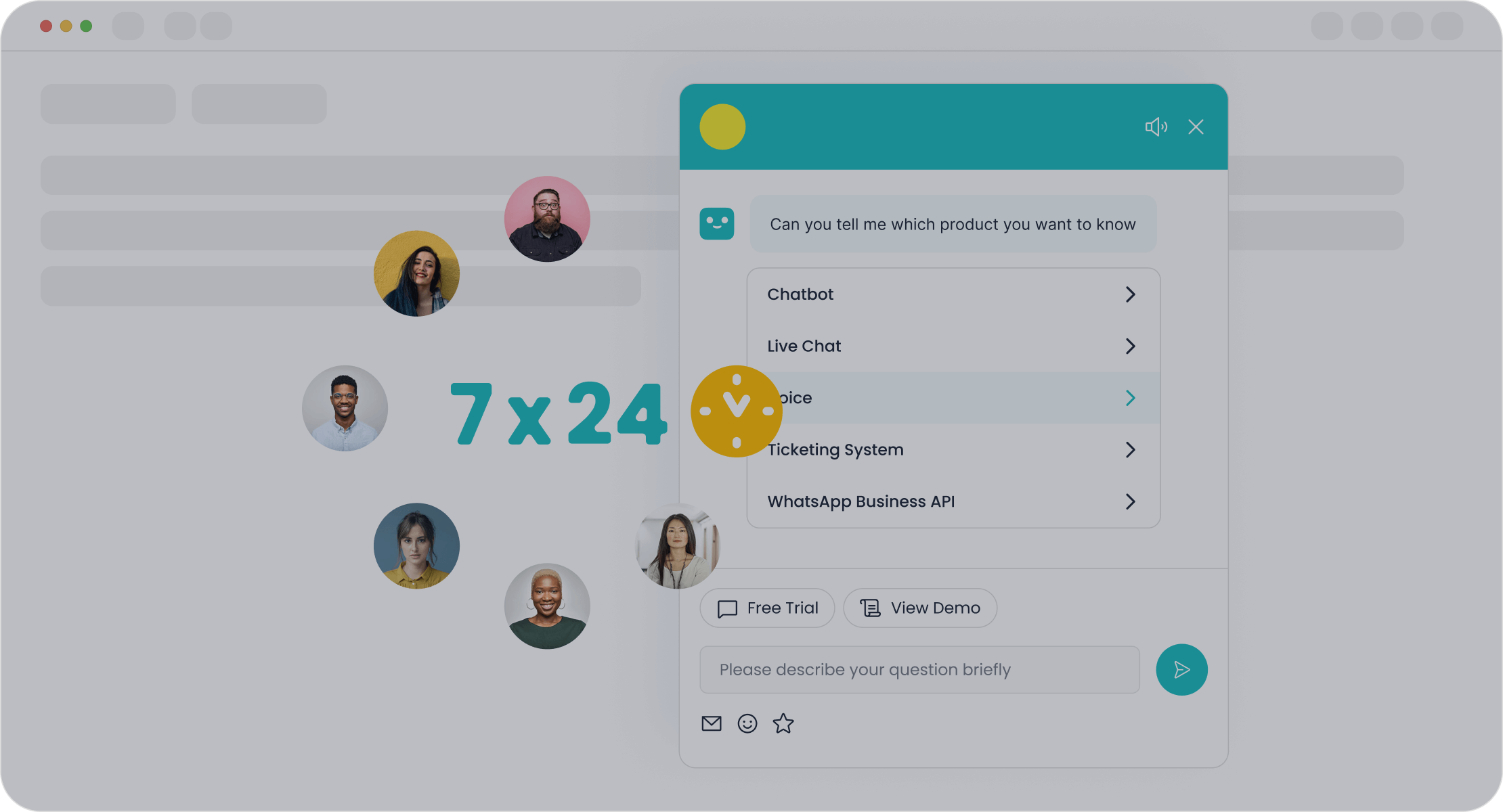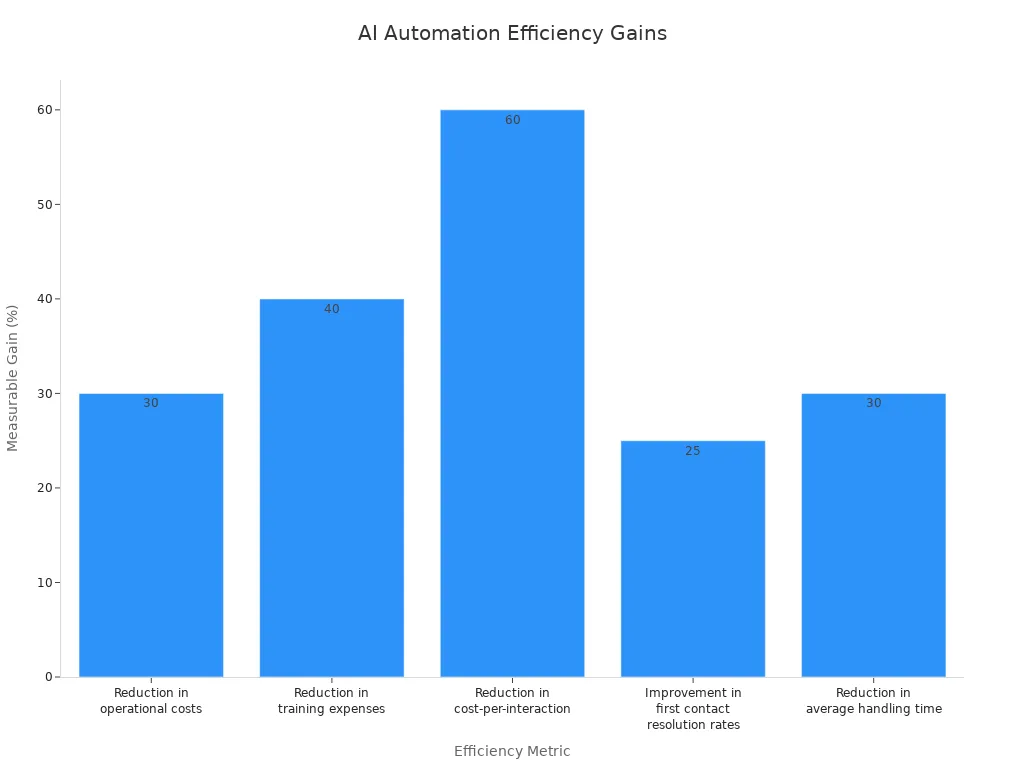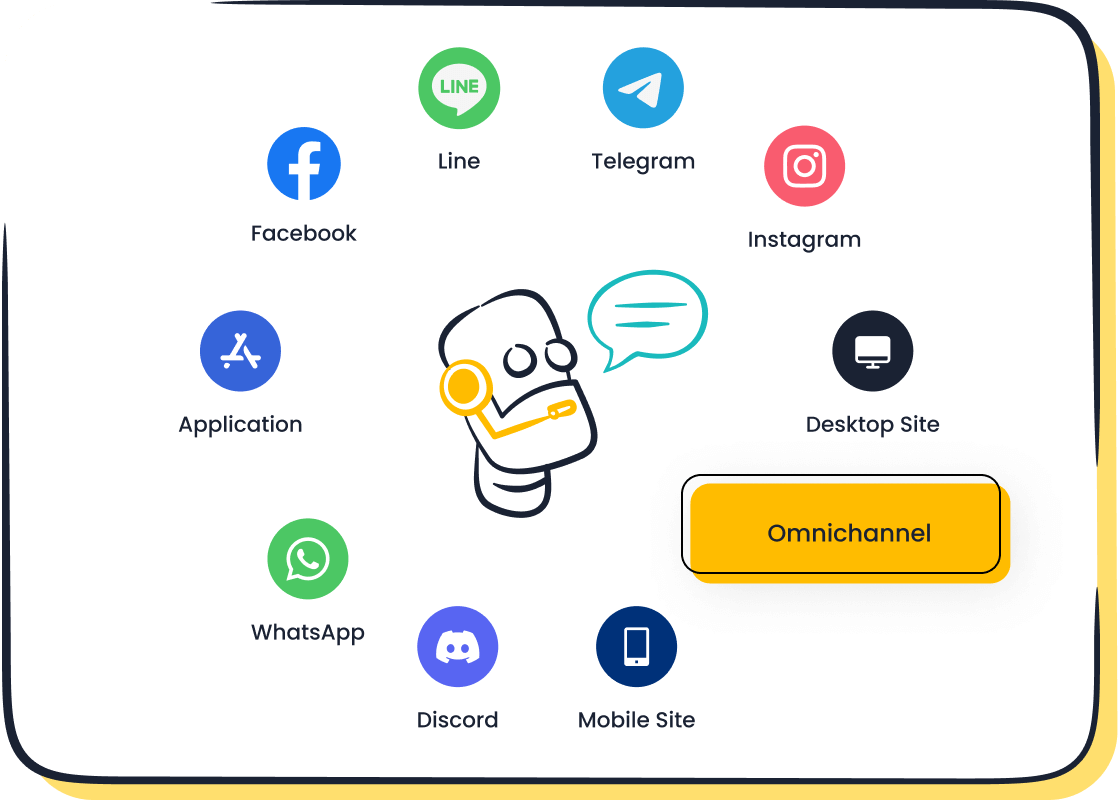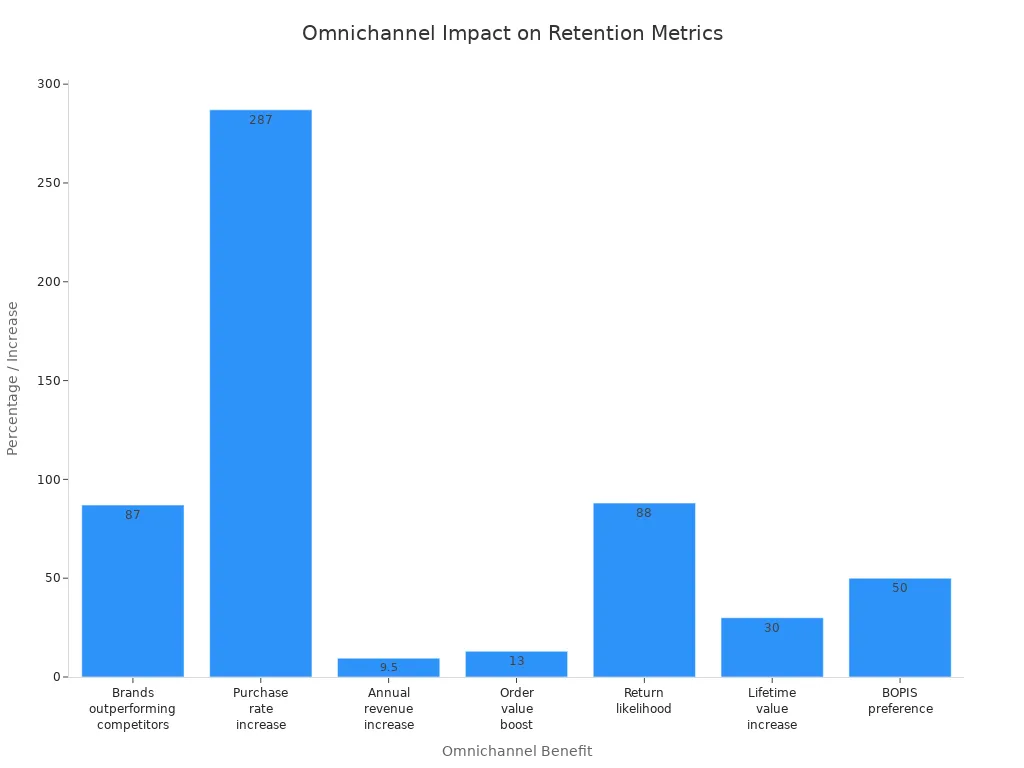Top Customer Service Objective Shifts for the Year Ahead

Businesses face urgent pressure to adapt customer service objectives in 2025. Customer expectations now demand fast, personalized, and secure service. Industry data shows that 40% of companies plan to invest in chatbots, while 90% of customer experience leaders will boost spending on self-service and AI solutions. AI powers Sobot call center automation and enhances personalization, which has become a top priority. Data privacy ranks high, with 83% of leaders making it central to customer service strategies. Sobot AI helps unify omnichannel experience and drive these new customer service trends, ensuring companies meet evolving priorities and deliver standout customer service.
Customer Service Objective Shifts
Definition
Customer service objective shifts describe the evolving priorities and strategies that guide how organizations deliver service and support. Experts now define these shifts as a move from reactive, transactional support to proactive, journey-focused customer experience management. Companies no longer view service as a single touchpoint. Instead, they see it as a continuous relationship that spans every interaction. Customer experience teams use data analytics, AI, and cross-department collaboration to personalize and improve customer experiences. These priorities now include mapping the entire customer journey, measuring satisfaction through metrics like NPS and CSAT, and aligning service with broader business goals. Sobot, for example, helps brands unify service channels and automate support, reflecting this new approach.
Importance in 2025
In 2025, customer service objective shifts will matter more than ever. Industry analysts report a rapid increase in AI investment, with 79% of support teams planning to adopt advanced tools. These priorities enable companies to scale service without increasing headcount. Only 19% of teams feel current technology meets their needs, so the demand for innovation remains high. Customer expectations have changed, with 77% of business leaders seeing personalized support as crucial for retention. Companies like Sobot address these priorities by offering AI-powered chatbots and omnichannel solutions that meet rising customer expectations and service demands.
Note: Forrester’s 2024 US Customer Experience Index shows only 3% of companies achieve true customer obsession, highlighting the need for new customer service priorities and strategies.
Impact on Customer Experience
Customer service objective shifts directly impact customer experience and loyalty. Research shows that embedding support throughout the customer journey increases satisfaction and builds stronger relationships. Companies that focus on both efficient processes and personalized assistance see higher loyalty rates. For example, Sobot’s unified service platform allows agents to access customer data and deliver seamless experiences across channels. This approach addresses ongoing challenges, such as 52% of customers feeling exhausted by support interactions. By prioritizing customer-centric service, organizations improve satisfaction, foster loyalty, and stay ahead of customer service trends.
- Key impacts include:
- Enhanced satisfaction through continuous support
- Improved loyalty due to memorable customer experiences
- Greater efficiency and personalization using AI and data analytics
AI Automation with Sobot Chatbot

AI Trends
The customer service industry is experiencing rapid change as ai transforms support operations. Companies now rely on ai to automate routine tasks, analyze customer sentiment, and deliver personalized experiences. Several trends define the landscape in 2025:
- The chatbot market will grow by $1.34 billion, fueled by advances in natural language processing and machine learning.
- Conversational generative ai is expected to reduce contact center labor costs by $80 billion by 2026, automating 10% of agent interactions (Gartner).
- 65% of businesses plan to expand ai use in customer support within the next year.
- 63% of organizations have started ai training programs for customer experience teams.
- Ai-powered sentiment analysis detects customer emotions in real time, improving personalization.
- Ai tools automate customer satisfaction scoring and generate conversation summaries for agent training.
- Intent categorization with ai helps companies optimize support strategies.
- By 2025, 80% of customer service organizations will use conversational generative ai to automate repetitive tasks and improve productivity.

Sobot Chatbot leads this shift by providing businesses with advanced ai-powered automation, multilingual support, and seamless integration across channels.
Efficiency Gains
Organizations that adopt ai automation in customer service see measurable improvements. Sobot Chatbot enables companies to handle thousands of interactions at once, reducing wait times and increasing customer satisfaction. Ai-driven automation lowers operational costs and allows agents to focus on complex issues. The following table highlights key efficiency gains:
| Efficiency Metric | Measurable Gain Achieved |
|---|---|
| Reduction in operational costs | Up to 30% |
| Reduction in training expenses | Up to 40% |
| Reduction in cost-per-interaction | Up to 60% |
| Improvement in first contact resolution rates | Up to 25% |
| Reduction in average handling time | Up to 30% |
| Autonomous issue resolution | 80% of common issues by 2029 |
| 24/7 service and multitasking | Ai handles multiple interactions simultaneously |

Sobot Chatbot’s use of ai and conversational generative ai ensures immediate assistance, personalized recommendations, and a hybrid approach where human agents handle complex or emotional queries. This combination improves service quality and drives higher customer loyalty.
Implementation Steps
Businesses can follow clear steps to integrate ai automation with Sobot Chatbot:
- Assess Service Needs: Identify repetitive queries and high-volume channels where ai can add value.
- Deploy Sobot Chatbot: Use Sobot’s no-code interface to set up workflows and automate common interactions.
- Integrate Channels: Connect Sobot Chatbot to preferred platforms like WhatsApp, SMS, and web chat for omnichannel support.
- Train Teams: Provide ai training for agents to maximize the benefits of conversational generative ai and ensure smooth collaboration.
- Monitor and Optimize: Use Sobot’s analytics to track performance, customer satisfaction, and ai-driven insights for continuous improvement.
Tip: Start with a pilot program to measure impact, then scale ai automation across more channels and use cases.
Sobot Chatbot empowers organizations to future-proof their customer service, reduce costs, and deliver exceptional experiences through advanced ai and conversational generative ai.
Omnichannel Customer Experience

Unified Platforms
Unified platforms have become essential for delivering a consistent customer experience. Companies now use centralized inboxes that combine emails and chats in one interface. This approach prevents missed messages and ensures every customer receives timely support. Real-time notifications alert agents to new inquiries, while unified search functions allow quick retrieval of past interactions. These features help agents maintain consistent service standards and avoid data silos. Businesses also benefit from seamless switching between communication channels, which boosts productivity and supports a true omnichannel strategy.
Companies with strong omnichannel engagement retain 89% of their customers, compared to only 33% for those with weak engagement. Year-over-year revenue growth reaches 9.5% for omnichannel leaders, far outpacing others.
| Metric | Omnichannel Companies (Strong Engagement) | Companies (Weak Engagement) |
|---|---|---|
| Customer Retention Rate | 89% | 33% |
| Year-over-Year Revenue Growth | 9.5% | 3.4% |
| Year-over-Year Cost per Contact Decrease | 7.5% | 0.2% |
Seamless Interactions
Seamless interactions define the modern customer experience. Customers expect to switch between channels—such as chat, email, or phone—without repeating their issues. Unified communication ensures that every interaction feels connected and personal. Key features include:
- Seamless cross-platform navigation for uninterrupted conversations.
- Personalized product recommendations based on previous customer experiences.
- Consistent branding and messaging at every touchpoint.
- Automated workflows that speed up self-service and response times.
- Real-time engagement for instant assistance and proactive problem solving.

Empirical studies show that omnichannel customer experience increases repurchase intentions and engagement, especially when strategies address specific customer needs and relationship phases.
Sobot Omnichannel Solution
Sobot’s Omnichannel Solution empowers businesses to deliver exceptional service across every channel. The platform integrates AI-driven automation, a unified workspace, and robust analytics. Companies report a 99.99% uptime, ensuring reliable service at all times. Integration with CRM and management systems happens quickly, exceeding expectations. Customer reception efficiency rises by 48%, while average handle time drops by 41%. First-contact resolution improves by 54%, and Net Promoter Scores increase within months.
| Benefit Description | Reported Improvement/Outcome |
|---|---|
| Service stability and robustness | 99.99% uptime |
| Integration with CRM and management systems | Ease and speed exceeded expectations |
| Customer reception efficiency | Increased by 48% |
| Net Promoter Score (NPS) | Increased after 2-3 months |
| Average handle time | Reduced by 41% |
| First-contact resolution rate | Improved by 54% |
| Call routing, recording, and management | Enhanced capabilities |
| AI-powered voicebots | Improved customer interaction |
| Real-time monitoring and global number support | Available |
Sobot’s solution supports self-service, allowing customers to resolve issues independently while agents focus on complex requests. The platform’s unified data and seamless integration create a superior customer experience, driving higher retention, increased revenue, and stronger loyalty.
Personalization in Support
Data-Driven Personalization
Personalization stands as a leading customer service trend for 2025. Companies now use data to deliver hyper-personalization at every stage of the customer journey. AI and machine learning help teams analyze customer preferences, behaviors, and past interactions. This approach allows agents to offer personalized service that makes each customer feel valued. Businesses see higher satisfaction and loyalty when they use a customer’s name, reference previous conversations, and tailor responses to unique needs. Follow-up messages and feedback requests reinforce the experience, turning routine support into memorable moments. Combining technology with empathy ensures advanced personalization remains effective and human-centered.
Personalization in customer support increases satisfaction by building trust and emotional connection. Customers respond positively to tailored interactions, which leads to improved retention and loyalty.
Custom Communication
Custom communication techniques drive strong results in customer experience. Companies that personalize messages see higher engagement and repeat purchases. For example, 76% of consumers value personalized communication, and 78% are more likely to buy again when they receive it (McKinsey & Company). Support leaders recognize this, with 89% viewing personalization as a key differentiator. AI-powered chatbots, like those from Sobot, collect customer context and deliver instant, relevant responses. Empathy in communication helps resolve issues and strengthens relationships. Conversational support across channels reduces effort and frustration, boosting ROI and customer loyalty.
- Personalized service includes:
- Using customer names and preferences
- Referencing past support tickets
- Offering tailored solutions and recommendations
- Maintaining continuity across channels
Tools and Strategies
Businesses need the right tools and strategies to deliver hyper-personalization at scale. Sobot’s AI-powered chatbot and omnichannel platform automate routine inquiries and personalize responses using real-time data. Machine learning enables smart ticket routing and predictive analytics, improving agent efficiency. Companies integrate customer data from all touchpoints, creating a single view for advanced personalization. Regular data audits and unified platforms ensure high data quality and accurate customer profiles.
| Strategy/Tool | Benefit for Customer Experience |
|---|---|
| AI-powered chatbots (e.g., Sobot) | 24/7 personalized service, instant replies |
| Omnichannel orchestration | Seamless experience across channels |
| Predictive analytics | Anticipates needs, customizes offers |
| Agent copilots and automation | Faster, more accurate support |
| Multilingual support | Personalized service for global customers |
Tip: Start with clear goals, unify customer data, segment audiences, and test personalization strategies. Address privacy and scalability to ensure sustainable success.
Hyper-personalization transforms customer service from generic to exceptional. Companies that invest in these tools and strategies see measurable gains in satisfaction, loyalty, and operational efficiency.
Data Security and Trust
Privacy Standards
Data security now stands at the center of customer service objectives. Recent incidents highlight the risks companies face. In 2025, organizations have experienced ransomware attacks, data breaches, and malicious code injections that disrupt customer service and compromise sensitive information.
| Date | Organization | Attack Type | Impact on Customer Service Operations |
|---|---|---|---|
| April 27, 2025 | Diallog Telecommunications Corp | RALord Ransomware | 50 GB of data stolen, threat to publish sensitive customer data within days. |
| April 27, 2025 | Hitachi Vantara | Akira Ransomware | Systems disruption affecting service availability. |
| April 02, 2025 | Royal Mail & Spectos GmbH | Data Breach | Third-party vendor breach exposed customer data, highlighting supply chain risks. |
| April 02, 2025 | Port of Seattle | Rhysida Ransomware | Personal information of 90,000 people compromised, requiring notification and remediation. |
| April 02, 2025 | Texas State Bar | INC Ransomware | Unauthorized network access led to theft of personal data including full names. |
| April 03, 2025 | City of Lubbock, Texas | Malicious Code Injection | Sensitive financial data of 12,000 utility customers stolen via compromised payment site. |
| April 03, 2025 | Europcar Mobility Group | GitLab Repository Breach | Source code and personal data of up to 200,000 customers stolen, with extortion threats involving cloud infrastructure. |
To meet customer expectations, service teams must comply with strict privacy standards. These include GDPR, CCPA, HIPAA, and PCI DSS. Best practices involve collecting only necessary data, encrypting sensitive information, and using multifactor authentication. Regular audits and transparent privacy policies help build trust and reduce risks.
Regulatory Compliance
Regulatory compliance requirements continue to evolve. In 2025, companies must follow laws such as GDPR for data privacy, HIPAA for healthcare, PCI DSS for payment security, DORA for financial resilience, and the EU AI Act for ethical AI use. Teams should:
- Conduct risk assessments to identify vulnerabilities.
- Train employees to recognize and prevent threats.
- Test incident response plans regularly.
- Audit third-party vendors to secure the supply chain.
- Monitor systems for real-time threat detection.
- Automate compliance tasks like patch management.
- Foster a culture of compliance throughout the organization.
These steps protect customer data and ensure operations meet legal standards.
Building Customer Trust
Strong data security builds customer trust and protects brand reputation. Compliance with privacy laws shows commitment to safeguarding customer information. Avoiding breaches and negative publicity helps maintain a positive image. Data breaches can cause lasting damage, making transparency and quick response essential. Centralized data management reduces risks and supports personalized service, which meets rising customer expectations.
Brands that prioritize data security deliver better customer experiences and receive more positive customer feedback. Sobot’s contact center solutions, for example, use advanced encryption and strict access controls to keep customer data safe. This approach helps companies earn trust, meet feedback standards, and exceed customer expectations in every interaction.
Employee Empowerment
Training and Skills
Empowering employees starts with strong training programs. Companies that invest in skill development see higher customer satisfaction and stronger customer relationships. Effective training covers communication, empathy, and problem-solving. Employees learn to listen, respond clearly, and handle difficult situations with care. Programs often include role-playing and scenario simulations to prepare staff for real-world challenges. Setting clear goals and using modern tools, such as AI-powered learning platforms, helps track progress and boost engagement. Regular monitoring of customer satisfaction scores and resolution times ensures training delivers results. Sobot supports these efforts by offering AI-driven knowledge bases and workflow automation, making it easier for teams to access information and deliver excellent service.
- Develop communication skills through active listening and clear language.
- Build empathy and emotional intelligence for better customer relationships.
- Train in problem-solving and creative thinking.
- Encourage a positive attitude and welcoming approach.
- Use role-playing and simulations for practical learning.
- Set measurable goals and blend theory with practice.
- Track key metrics like customer satisfaction and resolution speed.
- Leverage AI-powered tools for engaging, effective training.
Employee Experience
Employee experience shapes the quality of service and customer relationships. Engaged employees feel valued and connected to their company’s mission. This sense of purpose leads to better service and stronger customer relationships. Training and development give staff the skills to meet customer needs, while empowerment allows them to resolve issues quickly. Positive engagement creates a warm atmosphere that customers notice. High retention rates mean customers interact with knowledgeable staff, building trust over time. When employees and customers share values, authentic relationships form, boosting loyalty and satisfaction.
- Engaged employees deliver superior customer experiences.
- Training empowers staff to meet customer needs and improve satisfaction.
- Empowerment enables quick, personalized solutions.
- Positive engagement creates a welcoming environment.
- High retention ensures consistent, knowledgeable support.
- Shared values foster authentic customer relationships.
- Productivity and teamwork drive better service outcomes.

| Employee Empowerment Parameter | Correlation with Patient Satisfaction (Pearson r) | Significance (p-value) |
|---|---|---|
| Competence | 0.384 | p = 0.000 |
| Teamwork | 0.390 | p = 0.000 |
| Motivation | 0.351 | p = 0.000 |
| Rewards and Recognition | 0.437 | p < 0.05 |
Support Tools
Support tools play a key role in empowering customer service teams. These tools help agents manage inquiries, track performance, and access knowledge quickly. Live chat, CRM systems, and knowledge bases are essential for efficient service. As teams grow, quality assurance automation and centralized knowledge management become even more important. Sobot’s unified workspace and AI-powered chatbot provide agents with instant access to customer data and automated workflows, improving both efficiency and customer satisfaction. Selecting tools that integrate well, scale easily, and ensure data security supports long-term success and strong customer relationships.
| Support Tool | Core Use Cases / Features | Description / Benefits |
|---|---|---|
| Kaizo | Quality Assurance, Performance Management, Ticket Analysis, Performance Coaching, Workforce Engagement | AI-powered QA automation, sentiment analysis, and motivational tools |
| Gleap | Live Chat, Knowledge Base, Support Bot, Surveys, In-app Bug Reporting | AI-driven chatbot for fast, personalized interactions |
| SproutSocial | Audience Analysis, Consumer Research, Customer Feedback, Sentiment Research, Crisis Management | Social media monitoring and analytics for tracking engagement and satisfaction |
| KnowledgeOwl | Knowledge Management, Self-service Portal, Customer Contact Forms | Centralized knowledge base for agents and customers |
| Forumbee | Discussion Forums, Knowledge Base, Community Q&A, Moderation, Customer Ideation | Online forums for peer-to-peer support and stronger customer relationships |
| SurveyMonkey | Customer Satisfaction Surveys, Feedback Collection, Data-driven Insights, Market Research | Survey tool for gathering and analyzing customer feedback |
Tip: Choose support tools that match your team’s needs, offer strong integration, and support secure, scalable service delivery.
Balancing AI and Human Touch
Human-AI Collaboration
Human-AI collaboration shapes the future of customer service. Companies use ai to handle routine questions, process data, and automate simple tasks. Human agents focus on complex issues, emotional conversations, and building relationships. Recent case studies show that this hybrid approach increases efficiency and improves customer satisfaction. For example, a financial institution used ai voice agents to automate lead qualification. Human sales representatives then focused on consultative advice. This strategy led to a 25% increase in sales revenue and a 30% reduction in sales cycle length. Sobot’s platform enables seamless collaboration by letting ai manage repetitive inquiries while agents deliver empathy and creative solutions. This balance supports both hyper-personalization and operational excellence.
Empathy in Service
Empathy remains essential in customer service. While ai can provide fast answers and gather information, only humans can understand context, show compassion, and resolve sensitive issues. Customers value empathy, especially during stressful situations. Sobot’s solutions allow ai to detect frustration or complex needs and transfer customers to human agents when needed. This approach ensures that every customer receives the right mix of efficiency and care. Hyper-personalization becomes possible when ai collects data and humans use it to tailor responses. This teamwork builds trust and drives customer satisfaction.
Best Practices
Tip: Blending ai with human touch creates a service experience that is both efficient and personal.
- Use ai for routine inquiries and initial contact to speed up response times.
- Clearly define roles: ai handles FAQs and scheduling, humans manage complex or emotional issues.
- Program ai to detect frustration or complexity and transfer customers to agents with full context.
- Offer customers the choice to speak with a human at any time.
- Regularly update ai knowledge bases with current information.
- Monitor ai performance using metrics like accuracy and customer satisfaction.
- Collect feedback from both customers and agents to improve collaboration.
- Maintain transparency by informing customers when they interact with ai.
- Retrain staff for roles that require emotional intelligence and decision-making.
Sobot’s unified workspace and ai-powered tools help companies achieve this balance, ensuring that both personalization and efficiency drive business success.
Top Customer Service Trends for 2025
Proactive Support
Proactive support leads the list of top customer service trends for 2025. Companies now anticipate customer needs before issues arise. They use AI-powered tools to monitor interactions and identify patterns. This approach helps teams reach out with solutions, reducing frustration and increasing retention. Sobot’s platform uses generative AI to analyze customer feedback and predict common problems. Businesses can then send helpful tips or reminders, building stronger relationships and loyalty. Proactive support also improves customer engagement by showing customers that brands care about their experience.
Companies that adopt proactive support see a 20% increase in customer loyalty and a 15% boost in retention rates.
Self-Service Options
Self-service stands as a cornerstone among emerging customer service trends. Customers want instant answers and control over their support journey. Sobot’s AI-powered chatbots and knowledge bases provide 24/7 self-service customer support across all channels. These tools resolve tickets 52% faster and reduce costs by 30%. Self-service options include FAQs, automated chat, and interactive guides. Businesses benefit from higher engagement and lower operational costs. Customers appreciate the convenience, which leads to stronger relationships and increased loyalty. By 2025, 95% of interactions will involve self-service, making it essential for customer retention and satisfaction.
| Self-Service Feature | Benefit for Customers | Impact on Business |
|---|---|---|
| AI Chatbots | Instant answers | Lower costs, higher NPS |
| Knowledge Base | Easy access to information | Fewer tickets, faster resolution |
| Automated Workflows | Quick self-service resolution | Improved efficiency |
Customer Advocacy
Customer advocacy shapes the future of customer service trends. Satisfied customers become brand ambassadors, sharing positive experiences and driving new business. Companies encourage advocacy by collecting customer feedback and acting on it. Sobot’s omnichannel platform gathers insights from every interaction, helping businesses improve products and services. This focus on advocacy strengthens customer relationships and boosts loyalty. Engaged customers provide valuable feedback, which guides innovation and supports long-term retention. As customer engagement grows, so does the impact of advocacy on business success.
The rise of customer advocacy highlights the shift from transactional support to building lasting relationships. Brands that prioritize advocacy see higher retention and deeper loyalty.
Customer service priorities continue to evolve. Companies now focus on AI automation, omnichannel platforms, and employee empowerment. These priorities drive business success by improving efficiency and customer satisfaction. Sobot’s solutions help organizations align with these priorities and deliver seamless support. Leaders should review their current priorities and invest in advanced tools, such as Sobot’s AI chatbot and omnichannel workspace. Staying ahead of these priorities ensures strong customer loyalty and growth in 2025.
FAQ
What are the main customer service objective shifts for 2025?
Customer service objective shifts in 2025 focus on AI automation, omnichannel experience, data security, personalization, and employee empowerment. Companies like Sobot help brands adapt by offering unified platforms and AI-powered tools that improve efficiency and customer satisfaction.
How does AI automation improve customer service efficiency?
AI automation handles repetitive tasks, reduces wait times, and provides instant answers. For example, Sobot’s AI Chatbot can boost productivity by 70% and cut service costs by up to 50%. This allows human agents to focus on complex customer needs.
Why is an omnichannel experience important for customer service?
An omnichannel experience lets customers reach support through their preferred channels, such as chat, email, or phone. Sobot’s Omnichannel Solution unifies these channels, ensuring seamless interactions and higher customer retention rates—up to 89% for strong omnichannel engagement (source).
How does personalization impact customer loyalty?
Personalization builds trust and emotional connection. Research shows that 78% of customers are more likely to repurchase after receiving personalized support. Sobot’s AI tools use customer data to deliver tailored responses, increasing satisfaction and loyalty.
What steps can companies take to ensure data security in customer service?
Companies should encrypt sensitive data, follow privacy regulations like GDPR, and use secure platforms. Sobot’s contact center solutions use advanced encryption and strict access controls, helping businesses protect customer information and build trust.